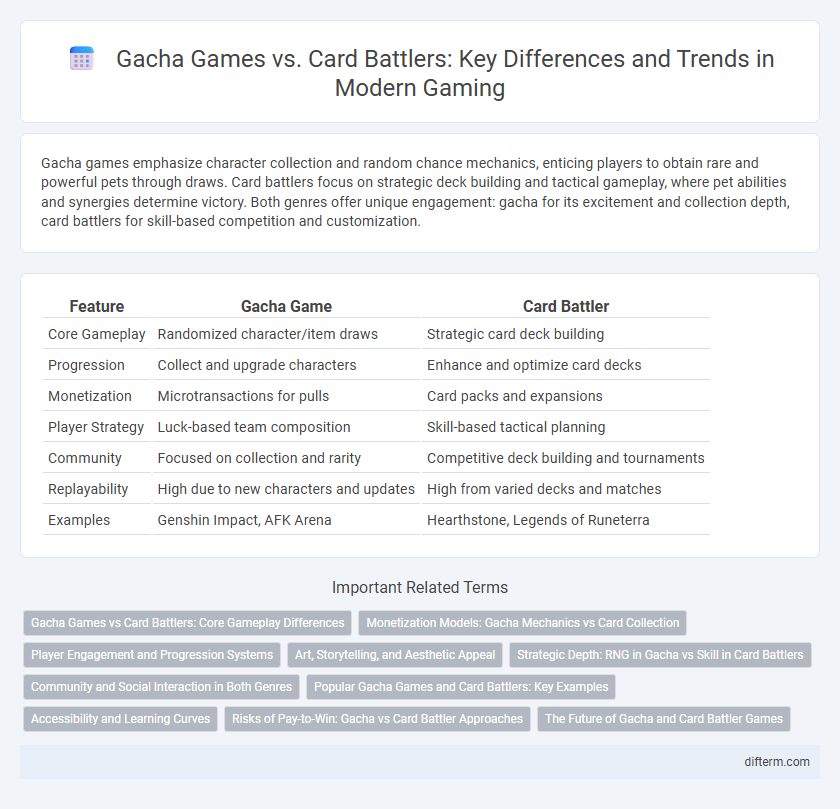Gacha games emphasize character collection and random chance mechanics, enticing players to obtain rare and powerful pets through draws. Card battlers focus on strategic deck building and tactical gameplay, where pet abilities and synergies determine victory. Both genres offer unique engagement: gacha for its excitement and collection depth, card battlers for skill-based competition and customization.
Table of Comparison
| Feature | Gacha Game | Card Battler |
|---|---|---|
| Core Gameplay | Randomized character/item draws | Strategic card deck building |
| Progression | Collect and upgrade characters | Enhance and optimize card decks |
| Monetization | Microtransactions for pulls | Card packs and expansions |
| Player Strategy | Luck-based team composition | Skill-based tactical planning |
| Community | Focused on collection and rarity | Competitive deck building and tournaments |
| Replayability | High due to new characters and updates | High from varied decks and matches |
| Examples | Genshin Impact, AFK Arena | Hearthstone, Legends of Runeterra |
Gacha Games vs Card Battlers: Core Gameplay Differences
Gacha games hinge on randomized character or item collection through microtransactions, emphasizing luck and long-term roster development, while card battlers focus on strategic deck building, resource management, and tactical play during matches. Gacha mechanics drive player engagement with character rarity tiers and upgrade systems, whereas card battlers prioritize skill-based decision-making and adaptable strategies to counter opponents. Both genres appeal to competitive players but differ fundamentally in progression dynamics and gameplay interaction.
Monetization Models: Gacha Mechanics vs Card Collection
Gacha games monetize primarily through randomized loot boxes where players spend in-game currency or real money for chances to obtain rare characters or items, driving continuous spending via excitement and rarity. Card battler games rely on a card collection model, encouraging purchases of specific card packs or expansions to enhance strategic decks, emphasizing collection completion and tactical depth. The gacha system fosters impulsive microtransactions tied to chance, while card battlers focus on deliberate investment in deck-building resources.
Player Engagement and Progression Systems
Gacha games rely heavily on randomized character or item acquisition, driving player engagement through chance-based excitement and continuous collection incentives. Card battlers emphasize strategic deck building and skill mastery, fostering deeper tactical involvement and long-term planning for progression. Both systems utilize reward loops, but gacha games prioritize novelty and variability, while card battlers focus on player skill development and strategy optimization.
Art, Storytelling, and Aesthetic Appeal
Gacha games often emphasize vibrant, character-driven art styles and dynamic animations that enhance player engagement, while card battlers focus on intricate card designs and thematic consistency that appeal to strategy enthusiasts. Storytelling in gacha games is typically intertwined with character collection and progression, offering episodic narratives that deepen emotional investment. Card battlers prioritize immersive lore and world-building conveyed through card text and visual symbolism, creating a cohesive aesthetic that complements tactical gameplay.
Strategic Depth: RNG in Gacha vs Skill in Card Battlers
Gacha games rely heavily on RNG (random number generation) to determine the rarity and power of collectible characters, introducing an element of luck that heavily influences player success. In contrast, card battler games emphasize skill-based strategy, requiring players to make calculated decisions about deck building, card synergy, and tactical plays during battles. This focus on skill in card battlers creates a more consistent and competitive environment where strategic depth outweighs randomness.
Community and Social Interaction in Both Genres
Gacha games foster vibrant communities centered around character collection, with players frequently sharing strategies and celebrating rare pulls, creating a dynamic social environment. Card battlers emphasize strategic interaction through multiplayer modes and tournaments, encouraging collaboration and competition that deepen player connections. Both genres utilize guilds and chat features to enhance social engagement, but gacha games often have a stronger focus on cooperative events and collective achievements.
Popular Gacha Games and Card Battlers: Key Examples
Popular gacha games like Genshin Impact and Fate/Grand Order dominate mobile gaming with their character collection mechanics and randomized draws. Key card battlers such as Hearthstone and Legends of Runeterra emphasize strategic deck-building and tactical gameplay. Both genres thrive on player engagement through unique systems of progression and competitive play.
Accessibility and Learning Curves
Gacha games offer streamlined mechanics with simple collection and upgrade systems, enhancing accessibility for new players. Card battlers feature complex strategies and diverse card synergies, resulting in steeper learning curves that appeal to experienced gamers seeking depth. Both genres cater to different player preferences by balancing ease of entry and strategic complexity.
Risks of Pay-to-Win: Gacha vs Card Battler Approaches
Gacha games often carry higher risks of pay-to-win due to randomized loot boxes that encourage continual spending to obtain powerful characters or items, creating a significant paywall impact on competitive balance. Card battlers, while also featuring purchasable packs, typically allow for more strategic deck-building and skill-based play, reducing the reliance on financial investment to succeed. Both genres risk alienating players with aggressive monetization, but card battlers generally offer a more equitable gameplay environment despite optional purchases.
The Future of Gacha and Card Battler Games
The future of gacha and card battler games is shaped by evolving player preferences and innovative monetization models, with gacha games leveraging randomized reward systems to maintain engagement. Card battler games emphasize strategic depth and collectible mechanics, appealing to competitive communities and esports integration. Advances in blockchain technology and cross-platform play are set to redefine ownership and accessibility within both genres, driving sustained growth and player retention.
gacha game vs card battler Infographic

 difterm.com
difterm.com